|
|
|
Sort Order |
|
|
|
Items / Page
|
|
|
|
|
|
|
| Srl | Item |
| 1 |
ID:
175446
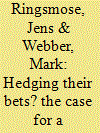

|
|
|
|
|
| Summary/Abstract |
President Donald Trump has adopted a critical position on NATO, raising concerns of an American abandonment of its obligations to Europe’s defence. The severity of Trump’s position is unusual, but some of his concerns are of long-standing and likely to be voiced in some form by his successor in the White House. American criticism and equivocation has led the European allies to engage in various forms of hedging. Some of these strategies are designed to keep the US attached to NATO; others bypass the alliance – cultivating either bilateral links to the US or a strengthening of EU defence cooperation. Hedging, whatever its form, is potentially damaging to alliance effectiveness and cohesion. In that light, NATO’s interests are better served by a strategy which builds upon the NATO-EU relationship and which advertises the benefits of European effort within NATO itself. To that end, we argue in favour of a reformulation of an old but much misunderstood idea – that of NATO’s “European pillar.” Here, existing contributions to European defence provided by the allies through NATO are crucial. Such an arrangement need not, therefore, entail any elaborate institutional engineering, but it does require political and strategic clarity.
|
|
|
|
|
|
|
|
|
|
|
|
|
|
|
|
| 2 |
ID:
121244
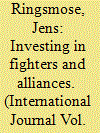

|
|
|
|
|
| Publication |
2013.
|
| Summary/Abstract |
In the spring of 1975 Norway and Denmark were faced with the choice
of how to replace their aging fleets of fighter jets. Together with Belgium
and the Netherlands, the two Nordic countries had established a "buyers'
consortium" to ensure NATO standardization and a strong bargaining
position vis-à-vis the potential suppliers; hence Copenhagen and Oslo
were in very similar situations. As the final decision was about to be made,
three candidate planes were still in the competition: the American F-16, the
Swedish Saab Viggen, and the French Dassault Mirage. After a drawn-out
and exceedingly complex decision-making process, the four European NATO
members together opted for the American contender. Surely, the Danish
and Norwegian decision to procure the F-16 had several reasons behind it-
importantly, most policymakers in both Copenhagen and Oslo considered
the American aircraft to be technically superior to its competitors-but
the choice of the F-16 was in no small part motivated by old-fashioned realpolitik. The purchase of new fighter jets was thus not only perceived as a
procurement of new military equipment but also an investment in alliances
and the transatlantic link. Accordingly, Norway and Denmark chose the
American F-16 partly because this aircraft was thought to bring the greatest
strategic benefits.1
|
|
|
|
|
|
|
|
|
|
|
|
|
|
|
|
| 3 |
ID:
098392
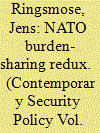

|
|
|
|
|
| Publication |
2010.
|
| Summary/Abstract |
Since the end of the Cold War, the debates about NATO burden-sharing have changed considerably, yet descriptions of the basic burden-sharing dynamics have changed little since the Cold War era. This article shows that burden-sharing disputes remain a basic alliance problem, but they have changed fundamentally since 1989. The most salient burden-sharing disputes are worse today, illustrated most profoundly by experiences in Afghanistan. This article contrasts the major disparities between in alliance contributions during the Cold War and today. Working within the framework of collective goods theory, the article shows that NATO's ability to project military power is best accounted for by traditional security functions that the alliance still serves. Because of disputes and uncertainty over its strategic roles, and the tendency for many members to still perceive it as a vehicle for 'keeping the Russians out, the Germans down, and the Americans in', collective action problems related to out-of-area operations remain serious, but can be assuaged through careful management.
|
|
|
|
|
|
|
|
|
|
|
|
|
|
|
|
| 4 |
ID:
156090
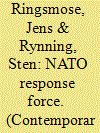

|
|
|
|
|
| Summary/Abstract |
This article reviews the gloomy saga of the EU Battlegroups, focusing on four questions: Where do they come from? What do they look like? What have they been hindered by? And where do they go from here? It builds upon earlier findings in the literature and adds novel insights based on original data. In doing so, the article pays particular attention to the standby nations’ constant calculation of political and financial costs. It argues that recognizing these cost–benefit calculations allows for identifying the most crucial areas to be tackled to make the EU Battlegroups functional. In addition, the article stresses that these considerations play out in a setting wherein the Battlegroups are just one among many policy instruments available for rapid response.
|
|
|
|
|
|
|
|
|
|
|
|
|
|
|
|
| 5 |
ID:
181192
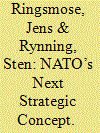

|
|
|
|
|
| Summary/Abstract |
NATO has embarked on the renewal of its Strategic Concept, the latest version of which dates to 2010. The question is whether this opportunity for renewal will result in a broad and elastic set of core tasks that have wide political appeal but that are ill suited to meet NATO’s strategic challenges. The Alliance opted for political convenience in 2010, and since then the complexity of Alliance politics has only increased. Allowing political considerations to dictate the contents of the new Strategic Concept would, however, bode ill for NATO’s ability to manage not only great-power competition but also an internal political–military divide that has become increasingly visible as NATO has adapted to Russia’s post-2014 revisionism. NATO’s next Strategic Concept should therefore put collective defence at the top of its list of priorities, reinvigorate NATO’s narrative of values, and encourage enhanced and sustained in-house political–military dialogue.
|
|
|
|
|
|
|
|
|
|
|
|
|
|
|
|
| 6 |
ID:
096852
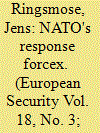

|
|
|
|
|
| Publication |
2009.
|
| Summary/Abstract |
At the Riga Summit in November 2006, NATO (North Atlantic Treaty Organization) declared the NATO Response Force (NRF) a fully operational capability. Yet only 8 months later - and behind closed doors - the Alliance's military authorities rescinded the declaration as it became increasingly clear that member states were unwilling to make the necessary commitments to the force. To this day, the force has been a qualified failure: while many allies have benefited from participating in the NRF, lack of concrete troop commitments and disagreement as to the force's operational role have largely eroded its credibility. This could change with the allies' recent adoption of a revised NRF-construct. However, as NATO is still in a state of strategic confusion, the NRF is likely to continue to be different things to different nations.
|
|
|
|
|
|
|
|
|
|
|
|
|
|
|
|
| 7 |
ID:
153362
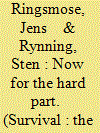

|
|
|
|
|
| Summary/Abstract |
NATO’s July 2016 Warsaw Summit was a crowning achievement in terms of Alliance adaptation. Taking place on the territory of a former Soviet vassal state (Poland), the summit consecrated the Alliance’s embrace of a renewed strategy of deterrence by punishment vis-à-vis Russia. The punishing intent, reminiscent of the Cold War, is made clear in the section of the summit’s declaration on nuclear policy, in which the allies state that
|
|
|
|
|
|
|
|
|
|
|
|
|
|
|
|
| 8 |
ID:
086555
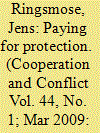

|
|
|
|
|
| Publication |
2009.
|
| Summary/Abstract |
Since the creation of the Atlantic Alliance in 1949, the Alliance's minor partners have persistently spent a smaller share of their Gross Domestic Product (GDP) on military measures than their larger brothers-in-arms do. Taking my cue from collective goods theory, I examine the factors shaping the armament behaviour and military spending patterns of the smaller allies. The article's main theoretical argument is that the smallest among allies tend to perceive their military instruments as the price of admission to a collective defence organization upheld by larger and more potent powers. In essence, military spending becomes the price of security guarantees and protection. Consequently, small allies raise their military expenditures when their security-guaranteeing senior partner threatens with sanctions that the small ally considers more costly than the requested increase in military expenditures and not as a response to rising threats. In the second section of the article, this theoretical claim is illustrated and assessed against Denmark's Cold War defence policies. The empirical findings corroborate the belief that the small allies' leading policy-makers view their armed forces as a necessary evil maintained in order to profit from their senior partners' capabilities.
|
|
|
|
|
|
|
|
|
|
|
|
|
|
|
|
| 9 |
ID:
158957
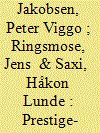

|
|
|
|
|
| Summary/Abstract |
In this article we broaden the conventional understanding of prestige and show that prestige-seeking played a major role in the Danish and Norwegian decisions to provide military support to post-Cold War US-led wars. Both countries made costly military contributions in the hope of increasing their standing and prestige in Washington. Both governments regarded prestige as a form of soft power, which they could later convert into access, influence, and US support. Our findings are far from trivial. They make a theoretical contribution by demonstrating that small powers understand and seek prestige in ways that differ fundamentally from the ways great powers do. They also help to explain why smaller US allies made costly contributions to the Balkan, Afghan, Iraq, and Libyan wars at a time when there was no direct threat to their national security and their security dependence on the United States was low. The high value that small US allies attach to their visibility and prestige in Washington suggests that it is far easier for the United States to obtain military support from smaller allies than Realist studies of burden-sharing and collective action problems would lead us to expect.
|
|
|
|
|
|
|
|
|
|
|
|
|
|
|
|
| 10 |
ID:
108769
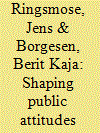

|
|
|
|
|
| Publication |
2011.
|
| Summary/Abstract |
This article seeks to explain variations in public support for the deployment of military troops to Afghanistan by means of the strategic narratives employed by national governments. Focusing on the UK, Canada, the Netherlands and Denmark, we argue that strong narratives about the why-what-and-how of overseas military missions increase the likelihood of popular support, while weak story lines are likely to result in a souring public opinion environment. Contrary to most current studies of public opinion and the support for international missions, we thus emphasise the role played by political leaders in shaping public attitudes towards the projection of military power. Surely, politicians are affected by polls and the wishes of public opinion - but popular attitudes are far from immune from political elites' attempts to rationalise the use of military force via strategic narratives.
|
|
|
|
|
|
|
|
|
|
|
|
|
|
|
|
| 11 |
ID:
086293
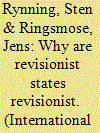

|
|
|
|
|
| Publication |
2008.
|
| Summary/Abstract |
In this article, we argue that Realism recently has eschewed big and important questions of war and peace and that revived Classical Realism can help bring Realism back on track. Modern Realists tend to assume that states are either all status quo players or all revisionists, and the result is a slippery grasp of the sources and dynamics of international change. To revive Classical Realism, we examine three dominant sets of criticism. We notably return to the classical texts of Realism to show that the classics were in fact not reductionist: they did not reduce either systemic or national phenomena (third and second image theory) to human nature (first image). Classical Realists understood the many intricate and delicate connections between these levels, and it is modern era Realists who are reductionists because they reduce explanations to systemic phenomena. We show how Classical Realism can respond in strength to its critics and ask the kind of research questions that again will advance our understanding of international change.
|
|
|
|
|
|
|
|
|
|
|
|
|
|
|
|
|
|
|
|
|